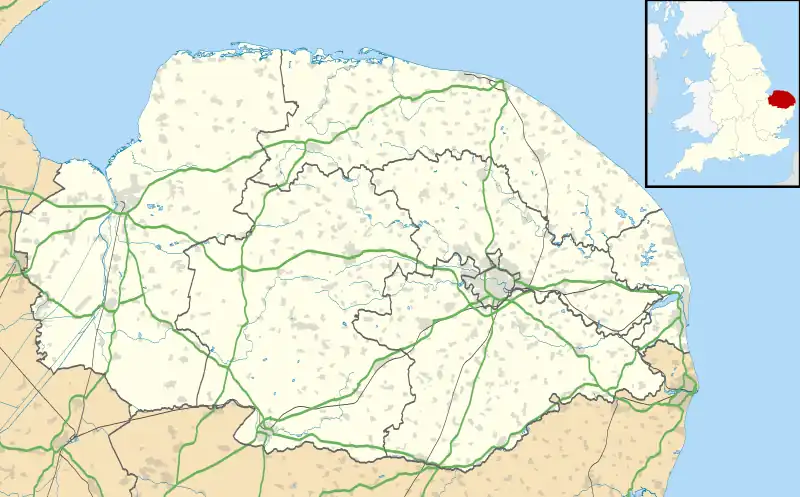| Norwich Guildhall | |
|---|---|
 The Guildhall | |
| Location | Norwich, Norfolk |
| Coordinates | 52°37′44″N 1°17′33″E / 52.6290°N 1.2924°E |
| Built | 1413 |
Listed Building – Grade I | |
 Location of Norwich Guildhall in Norfolk | |
Norwich Guildhall is a municipal building on Gaol Hill in the city of Norwich, United Kingdom. It is a Grade I listed building.[1]
History

The guildhall was commissioned after King Henry IV awarded a charter to the City of Norwich giving it autonomy from the county of Norfolk.[2] The building, which was quickly established as the new civic meeting place, was built between 1407 and 1413.[3] The roof of the Council Chamber collapsed in 1511 but restoration work did not begin until 1537.[4]
The Christian martyr, Thomas Bilney, was held in the dungeon (now the undercroft) before being burnt at the stake in August 1531.[5] The clock, by John Moore & Sons of Clerkenwell,[6] was a gift from Henry Woodcock, the mayor, in April 1850[7] and a large porch, designed by Thomas Barry, the City Surveyor, was added to the south side of the building in 1861.[1]
King George VI and Queen Elizabeth visited the guildhall and were shown the Council Chamber on 29 October 1938.[8] The Council Chamber ceased to be the local seat of government later that day, when the King and Queen went on to open the new City Hall.[5] In contrast, the Great Chamber was the judicial part of the building: it accommodated the quarter sessions and then the magistrates' courts and continued in that role until the new Law Courts in Bishopgate opened in the 1980s.[9][10]
In summer 2008 the guildhall became one of the twelve historic Norwich buildings in the Norwich 12 initiative, a project to develop an integrated group of heritage attractions in Norwich.[11][12] In July 2010 work began on the restoration and strengthening of the guildhall clock tower[13][14] and, in 2014, the Norwich Heritage Economic and Regeneration Trust took a 25-year lease on the building with a view to making it more accessible to the public.[15]
See also
References
- 1 2 Historic England. "The Guildhall, Norwich (1187384)". National Heritage List for England. Retrieved 26 August 2019.
- ↑ "Norwich Guildhall". Norwich 360. Retrieved 26 August 2019.
- ↑ "The Guildhall". Norwich 12. Archived from the original on 17 May 2010. Retrieved 28 September 2010.
- ↑ "The Guildhall". Medieval Stained Glass in Britain. Retrieved 27 July 2020.
- 1 2 "Norwich Guildhall". Norwich Heart Heritage Economic and Regeneration Trust. Retrieved 27 July 2020.
- ↑ Pickford, Chris, ed. (1995). Turret Clocks: Lists of Clocks from Makers' Catalogues and Publicity Materials (2nd ed.). Wadhurst, E. Sussex: Antiquarian Horological Society. p. 38.
- ↑ "East end of Guildhall, with 1850 clock tower". Recording Archive for Public Sculpture in Norfolk & Suffolk. Retrieved 27 July 2020.
- ↑ "When King George VI came to visit Norwich". Norwich Evening News. 23 October 2018. Retrieved 28 July 2020.
- ↑ "70: Norwich Guildhall". Eastern Daily Press. Archived from the original on 8 September 2010. Retrieved 28 September 2010.
- ↑ Pevsner, Nikolaus; Wilson, Bill (1997). Norfolk 1: Norwich and North-East. Yale University Press. p. 167. ISBN 978-0300096071.
- ↑ Ochyra, Helen (24 July 2009). "History by design". London: The Guardian. Retrieved 28 September 2010.
- ↑ "Heritage Open Days - Get On The Trail Of The Norwich 12". Culture 24. 10 September 2008. Retrieved 27 July 2020.
- ↑ "Norwich Guildhall to be restored". Evening News. 10 June 2010. Retrieved 28 September 2010.
- ↑ "Guildhall reconstruction work". Norwich City Council. Archived from the original on 11 September 2010. Retrieved 28 September 2010.
- ↑ "New vision for Norwich's Guildhall as public gain greater access to iconic building". Eastern Daily Press. 29 September 2014. Retrieved 27 July 2020.